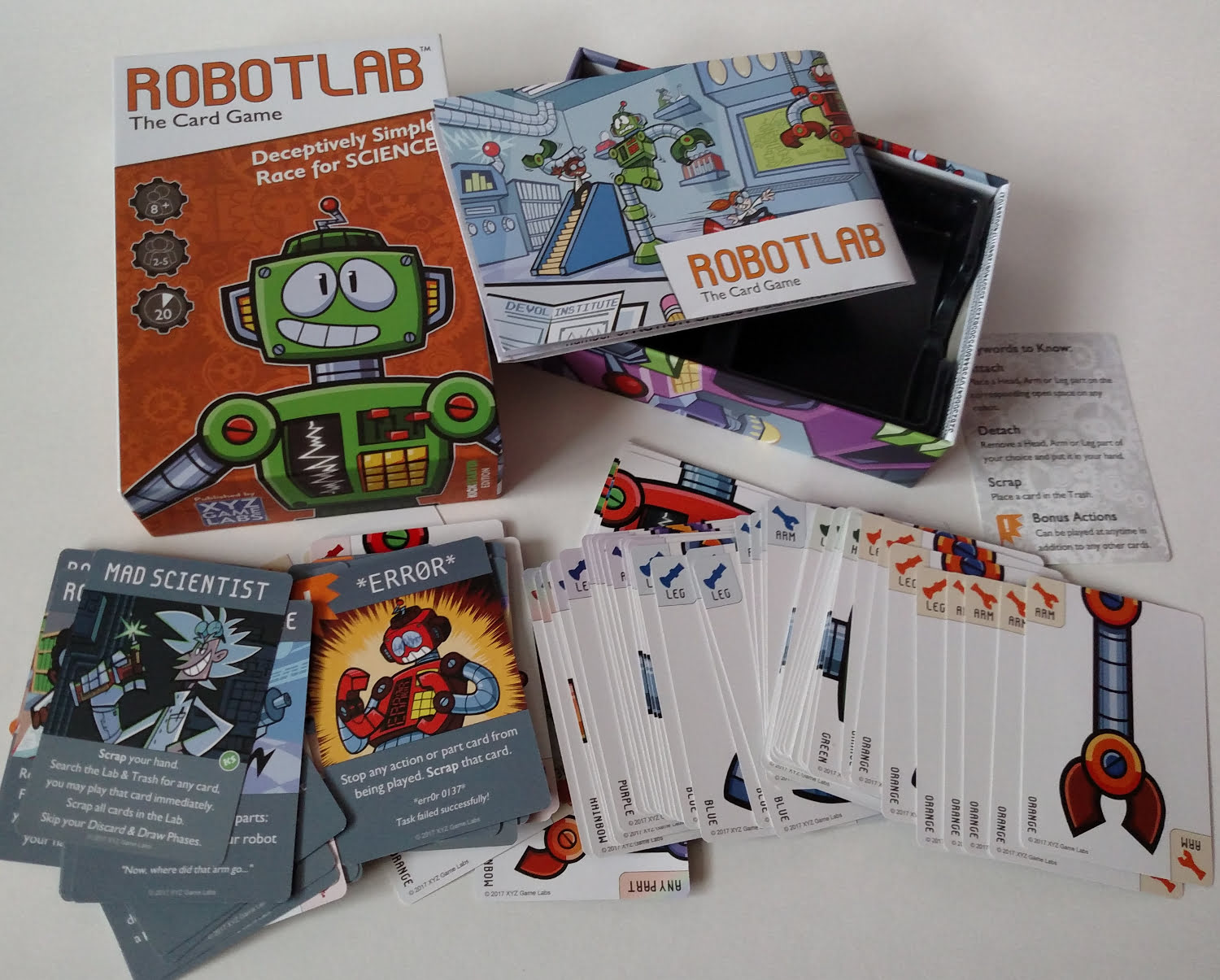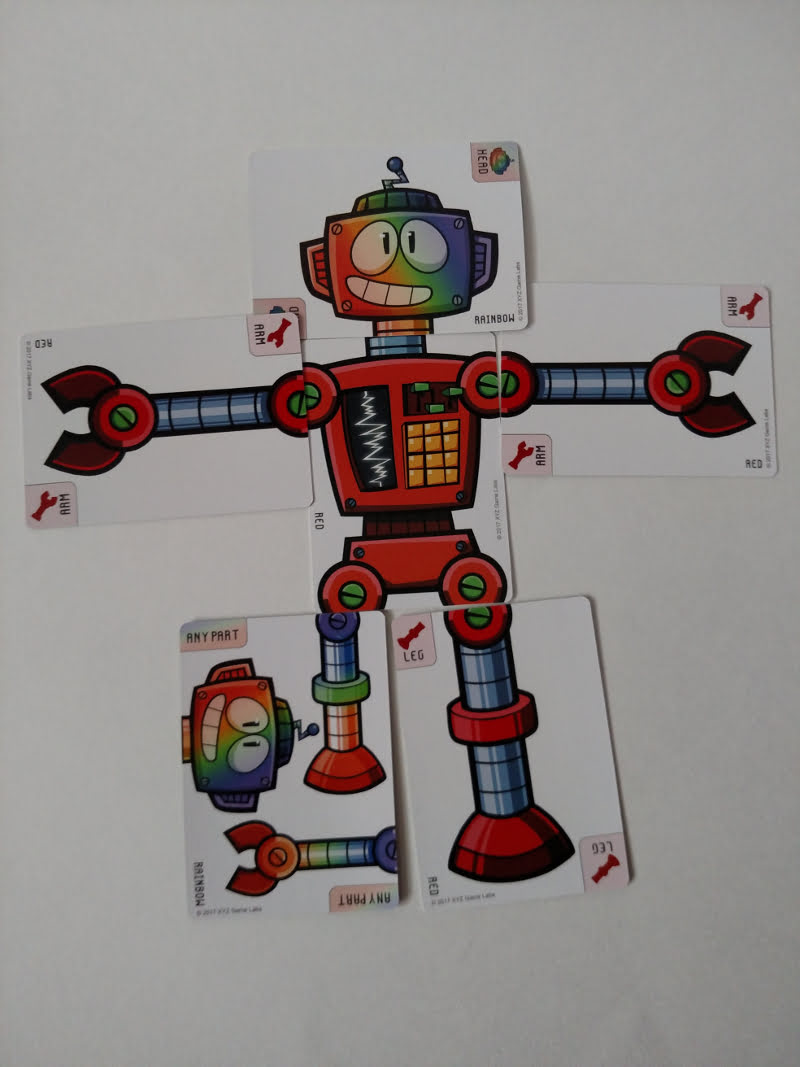One of my favorite things about Gen Con this year was the Gaming with GeekDad time I spent with a family on their first visit to the convention – and in particular, introducing them to RobotLab: The Card Game.

What is RobotLab?
RobotLab is a card game for 2-5 players, ages 8 and up, and takes about 20 minutes to play. Created by XYZ Game Labs, the game Kickstarted successfully in early 2017, and sells for $19.99. It’s a competitive game that’s easy to learn and mixes luck, strategy, and opponent interference.

RobotLab Components
Just 85 cards. (86 if you happen to have the Kickstarter edition.)
Here’s the card list:
- 5 Robot Body Cards (green, purple, orange, red, and blue)
- 55 Part Cards (11 parts in each color: 3 Heads, 4 Arms, 4 Legs)
- 4 Rainbow Part Cards (Arm, Leg, Head, and an “Any Part” card)
- 21 Action Cards of various counts, listed in the game instructions
The Kickstarter edition of the game includes an additional action card, the Mad Scientist.

RobotLab’s artwork – which I like for its Saturday-morning-cartoon feel – is by Galactabee.
Setup
Everybody chooses a body. A Robot Body card, that is. The color of the Robot Body determines the color robot each player will try to build. Any unused body cards get set aside. Shuffle the rest of the deck and stack the cards face down – this is the Lab. A discard pile – the Trash – will form next to it.
Choose the first player any way you see fit. In a two-player game, the first player should draw three cards from the Lab for their hand, and the second player then draws five. In games of 3 to 5 players, the first player draws three, and subsequent players draw four, except for the last player, who will draw a full hand of five cards.
And now you’re ready to play. To win, just complete your robot by adding two arms, two legs, and a head, all matching the body color. (Rainbow Part cards can go on any color robot, and the Any Part card includes a Head, Arm, and Leg.)
Gameplay
Each player’s turn consists of three phases:
- Build – You may either attach a part card to any robot – yes: your own or someone else’s – OR you may play an Action Card and do what it says. You only get to do one or the other. If you’re attaching a part, you have to attach it to an open space that corresponds to the part: You don’t play Part Cards on top of each other, and you don’t play arms on leg spots, or a head on an arm spot, etc.
- Discard – You may discard any number of Part Cards from your hand as long as they are all the same color (or rainbow). You may also discard any number of Action Cards by themselves or in combination with Part Cards. You must discard until you have no more than five cards in your hand.
- Draw – You end your turn by drawing cards from the Lab until you have five in your hand. If you already have five cards, you don’t draw any more: Your turn is over.
Once the Lab deck runs out, the Trash is shuffled and becomes the new Lab, but this doesn’t occur intil the Lab is empty AND a player is forced to draw a card.
And that’s it: Play continues clockwise around the table until someone has a complete robot.
Yes, you’ll notice that there’s no “Remove A Part” option. And that’s where the player interference comes in: When you start sticking non-matching colors on other folks’ robots, someone’s going to need an Action Card to come into play.
Here’s the Action Card breakdown:
- 5 Dig in the Trash cards – The player gets to pick any card from the trash and add it to their hand. They can play it immediately as long as anyone else’s robot has more parts (of any color) than theirs.
- 5 Robot Research cards – The player reveals the top 7 cards of the Lab to everyone, chooses one to attach to their own robot or keep in their hand, and scraps the rest.
- 3 Malfunction! cards – When played, the players with the most parts all scrap a part from their robot.
- 3 Disassemble cards – When played, players with the most parts all detach a part from their robot and keep it in their hand.
- 3 Reboot cards – The player scraps all cards in their hand and draws five new cards. They may also attach a part this turn, but if they do, they skip their discard and draw phases.
- 2 ERR0R cards – Playing this stops any action or part card from being played.
Additionally, the Malfunction!, Disassemble, and ERR0R cards have orange sunburst exclamation point symbols on them, designating them as Bonus Action cards: They can be played at any time, whether it’s your turn or not, or as soon as you draw them, or even (the game instructions note somewhat gleefully) as a reaction to someone else finishing their robot.
One other note: Players can look through the cards in the trash at any time, which can help shape a strategy.
Why You Should Play RobotLab
It’s easy to teach and learn, and it’s fun. (And I’d like to add a note of appreciation for the effort that went into creating a clearly-written and well-organized set of instructions. Few things frustrate me like an unclear rule set.) Even younger players should be able to catch on quickly on how to throw a monkey wrench into someone else’s plans, and the value of checking the trash to see whether that blue leg you need is there or not. There’s a nice level of strategy, despite the game’s simplicity.
Also, on a design note: I like that XYZ labs included words and symbols on each card to designate the color and part, just to keep things clear and accessible.
In fact, the game offers alternate rules if you’ve got a full crew of younger players: Just remove all the action cards, and during the first phase of a player’s turn, the options become Attach or Detach a part.
The Kickstarter version also includes a single Mad Scientist card, which, the creators note, “tends to make the game more dependent on luck.” The Mad Scientist directs the player to scrap their entire hand, search the Lab AND the Trash for any card, play it immediately, scrap all the cards in the Lab, and then skip the Discard and Draw phases.
RobotLab is a fun, quick play, and you don’t even have to take just my word for it: The family we played it with drove home six hours from Gen Con on Sunday, and when they got there, they broke out RobotLab.
XYZ Game Labs provided a copy of RobotLab for this review.





